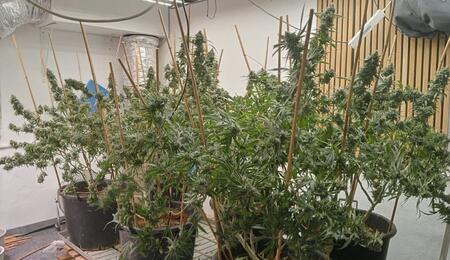All You Need to Know about Amino, Humic and Fulvic Acids

One of the most practical ways to start growing cannabis at home is to use soil and liquid nutrients. Did you know that plants rely on different types of available acids that play a major role in plant health and vitality? In this article, I explain all you need to know about amino, humic, and fulvic acids, how they affect cannabis plants, the benefits of using them, and much more.
What are amino acids?
Amino acids are essentially building blocks for proteins and are responsible for transporting Nitrogen, enzymes, and protein synthesis, as well as aiding in photosynthesis function. There are 21 different amino acids available to plants that affect hormone, cell wall development, and chlorophyll production. Amino acids act as plant growth regulators, meaning their application can enhance growth, structure, and yield, as well as have long-term benefits on soil quality and sustainability.
Research has proven that amino acids have numerous benefits when used on plants. Benefits will range from increases in stem size and root mass, improved resilience against airborne pathogens and pests, and a balance of available Nitrogen transported from the soil to the roots. During flowering, cannabis plants frequently fed with amino will produce a crop more resinous and aromatic than without.
How do cannabis plants use amino acids?
Cannabis plants will use amino, humic, and fulvic acids together to build strong stem walls with thick cell walls that are difficult to penetrate from insect attacks and pathogens. If you think about it as a thick entry barrier that stops insects feeding off the leaf tissue, preventing a potential infection.
Nitrogen and secondary metabolites found in the soil will become transported through amino acids and distributed to the different parts of a cannabis plant. Providing the soil with amino acids will have a direct effect on chlorophyll production and the overall health and colouration of the foliage.
The role of humic and fulvic acids in cannabis plants
Humic and fulvic acids are bi-products of organic material slowly decomposing over time, and converting itself to easily accessible nutrients and minerals. Not only do humic and fulvic acids allow nutrients to become more soluble, but they also greatly benefit the billions of microorganisms present in the soil food web, ensuring that there is a fine balance of readily available food and carbon for plants.
Imagine a liquid compost tonic that keeps plant vitality optimal and also increases resistance to pathogens and harmful bacteria that can attack soil or a plant’s roots. The other major role that humic and fulvic acids are responsible for is binding minerals and nutrients together, making them more accessible to plants. The way this is done is through chelation, which is a way of binding molecules together, increasing the amount of food a plant can use on demand.
How humic and fulvic acids benefit soil microbiology and plant health
There are a high number of benefits to keeping a well-balanced and healthy garden by using humic and fulvic acids. The quality of soil is significantly improved in the areas of soil structure, water retention, nutrient availability, and microbiology population, having a positive effect on root growth and development.
As a result, yields can be enhanced, as well as the overall quality of buds, meaning greater terpene, resin, and flower production.
What do humic and fulvic acids look like?
There are many types of humic and fulvic acids sold in grow shops, and they will have a shiny appearance and contain minimal aroma. Unlike black strap molasses which are produced from sugar cane, humic and fulvic acids are much lighter and should be added to your nutrient solution at 3-5 ml per liter from the earliest vegetation stage until the flush.
How to keep the soil well-balanced with top dressing.
One of the most important parts of maintaining top-quality soil that can be reused after each harvest is to keep enriching the soil with organic amendments. One of the easiest ways to provide microbe-rich feed is to top-dress your soil with fresh compost or worm castings.
Fish emulsion has many benefits when added to your current soil, and will slowly buffer nutrients back to the roots, whilst acting as a soil conditioner, increasing nutrient availability. The most practical way to top feed is to add an inch-high layer every 4–6 weeks during 18/6 and 12/12.
The benefits of combining amino, humic, and fulvic acids
A good organic grower will always make sure that there are optimal levels of amino, humic, and fulvic acids present in their growing medium. Beneficial bacteria and billions of microorganisms will use these building blocks and in return benefit cannabis plants as listed below.
- Plants will produce healthy and lush green foliage and full photosynthesis.
- Stems and branches will increase in size, resulting in stronger plants and yields.
- Plants become more resistant to attacks from insects and pathogens.
- Cannabis buds will be far superior in terpene production, resin, and essential oils.
- Soil becomes more absorbent and can hold nutrients and minerals for longer.
- The soil food web will thrive with a consistent level of humic and fulvic acids.
My conclusion
Growing mediums that are insufficient with humic, fulvic, and amino acids will have a poor rate of growth and small root mass causing plants to become stunted, and pale green resulting in low yields and end quality. Once you have the right levels of organic compounds available in hard food or liquid form, then the microbes and fungi present in the soil will do the rest of the work! They will convert what nutrients are necessary slowly over a 72-hour buffering period.
Foliar spraying your plants with amino acids when they are seedlings until early flower production is an excellent way to feed your crop, whilst supplementing them with all the essential nutrients and trace elements they may not be able to access in the soil. Simply use worm castings, fresh compost or fish emulsions mixed at 1-2ml per liter and spray the soil to regenerate any nutrient-deficient soil or growing mediums.



